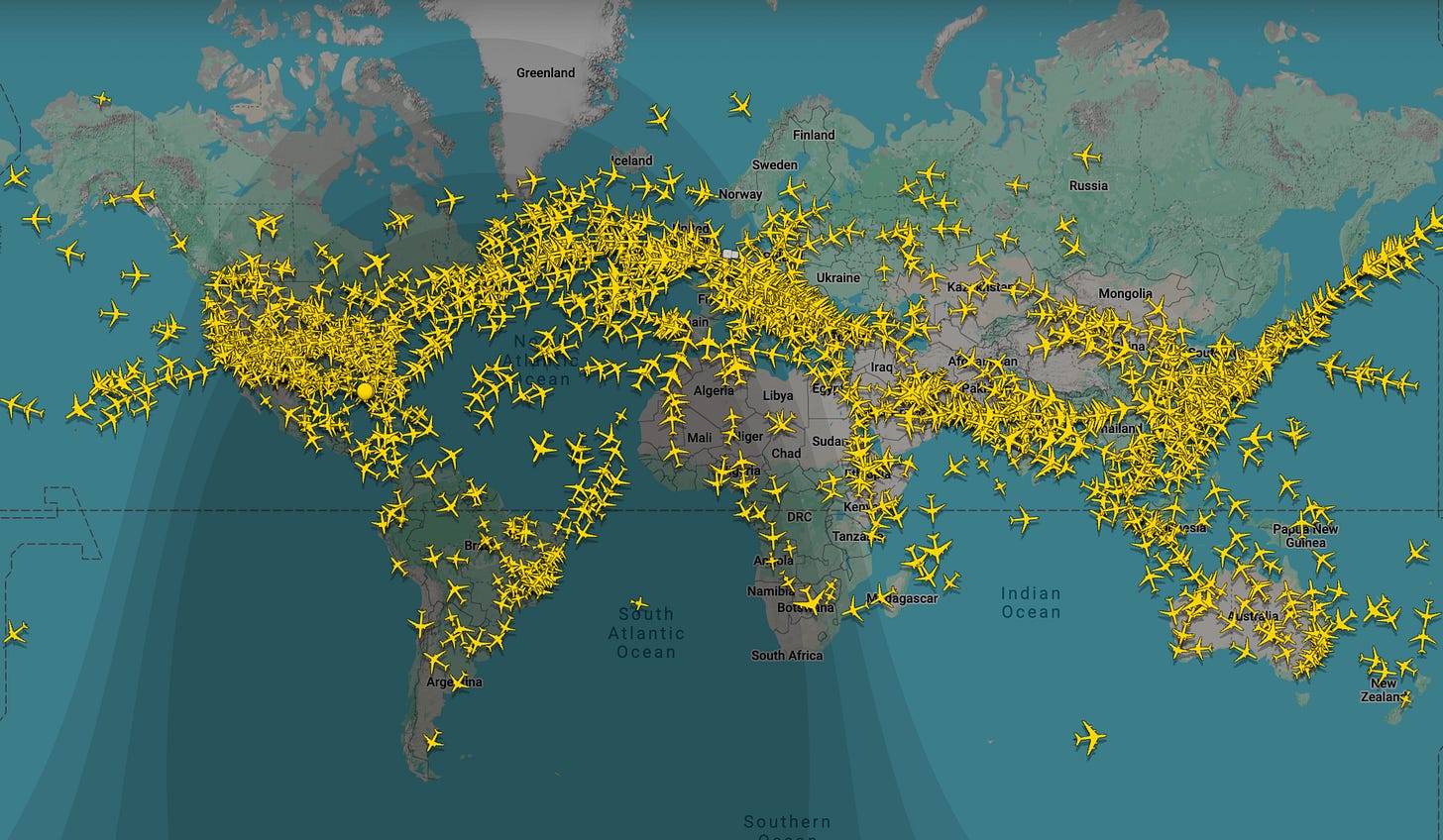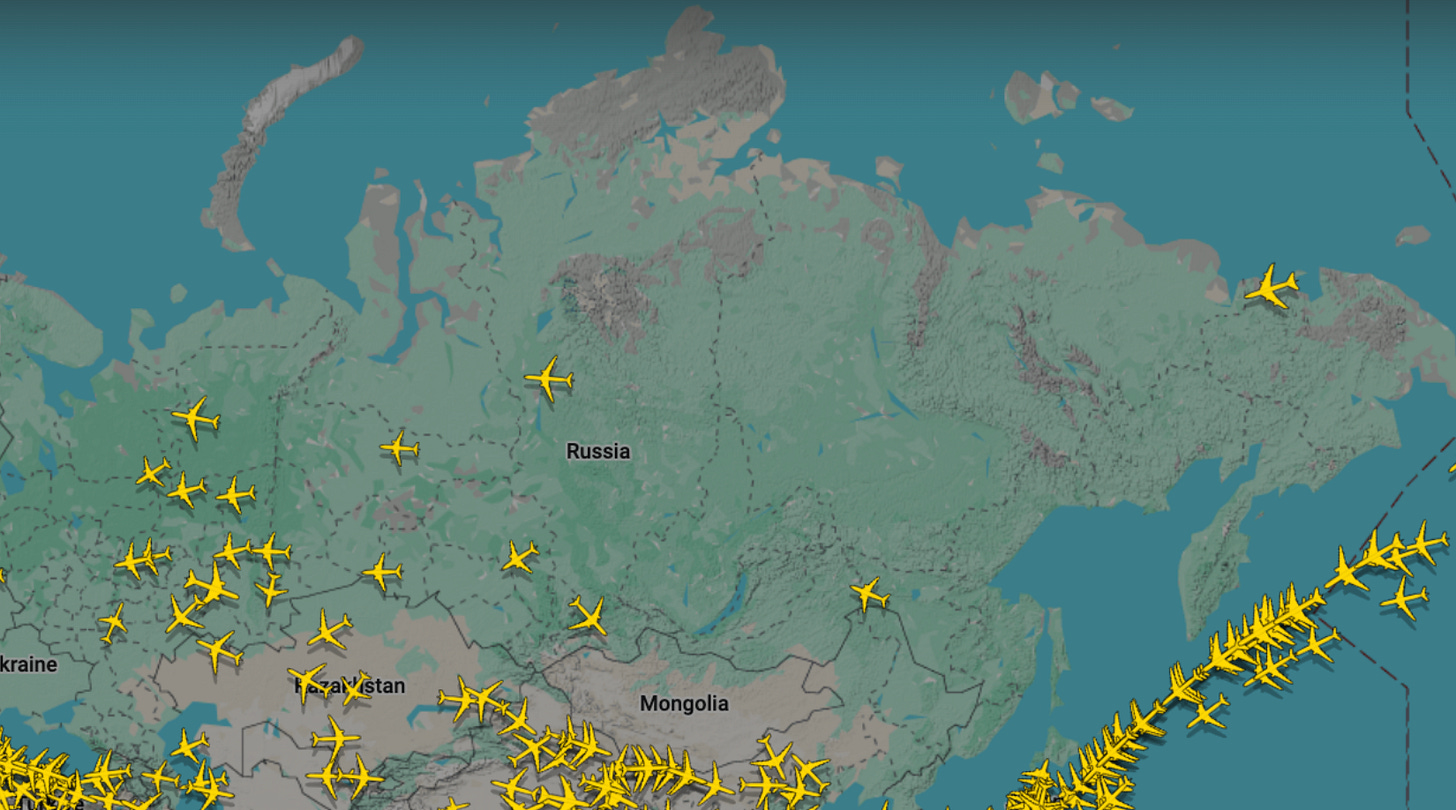A flight map is a war map
Want to understand geopolitics in 2025? Look up
If you want to understand the state of the world, you could do worse than gazing at a map of the skies. The aviation sector is, after all, predicated on the movement of millions of people and hundreds of millions of tonnes of cargo every day over vast distances, crossing national boundaries and diverse regulatory regimes, all while zipping along at 500mph in one of the most complex contraptions ever designed.
It is little wonder that few industries were harder hit by the Covid-19 pandemic, which saw borders shuttered, passengers ordered to stay at home, while supply chains were severed and entire economies virtually switched off overnight. The bounce-back in air travel has been one of the remarkable characteristics of the post-Covid world. London Heathrow, for example, saw a record-breaking 2024. But the sector faces some significant geopolitical headwinds.
A cursory glance at the above map tells us a few obvious things. The airspace over the United States and Europe is extremely busy, while the flight paths between the two continents, as well as the US and Asia, are clearly visible. There are also some notable blank spots for geographical reasons.
Aircraft tend not to fly over the Himalayan mountains, due to issues of air turbulence and limited emergency landing options. Then there are economic considerations. That lonely yellow plane in the southern Indian Ocean, Qantas Flight 641, speaks to the limited demand between southern Africa and Australia. But topography and economics alone cannot explain all the discrepancies. Geopolitics is a major — and growing — player.
First, there is Russia. Following Vladimir Putin’s decision to launch a full-scale invasion of Ukraine in February 2022, dozens of countries, including the US, UK, EU, Japan, Australia and Canada banned Russian airlines from operating in their airspace, which incurred a tit-for-tat response from Moscow, echoing Cold War strictures. As a result, Western airlines must fly an indirect route from Europe to Asia, which takes longer and costs more in terms of fuel, maintenance and staffing.
Then there is Ukraine itself, whose airspace was closed to commercial carriers at the same time, due to the risk to aircraft. You may also recall that in 2014, a missile brought down a Malaysia Airlines flight en route from Amsterdam to Kuala Lumpur, killing all 298 people on board. The incident took place amid fighting between the Ukrainian army and pro-Russian separatists in the Donbas region. A Dutch court ruled that a Russian-made missile brought down flight MH17.
More recently, airlines have halted flights to and from Israel, due to the war in Gaza. Only this week, Virgin Atlantic formally scrapped its London-Tel Aviv route. Meanwhile, flights were cancelled across the region when Iran struck Israel with a barrage of drones and missiles in April and October 2024.
Fast forward to Wednesday, when India closed its airspace to Pakistani airlines, in response to Pakistan’s banning of Indian airlines from flying over its territory. This is followed a terrorist attack on tourists in Kashmir, which killed 26 people. Pakistan revealed on Wednesday it had “credible intelligence” that India was set to launch military action. Consequently, non-Indian and Pakistani airlines including British Airways, Air France and Swiss have altered their routes to avoid Pakistan.
The above is not an exhaustive list. The Conflict Zone & Risk Database assesses the risk to airlines flying to or over all countries. Its classifications include three levels of airspace risk:
LEVEL 1: Moderate risk - No Fly
LEVEL 2: Assessed risk
LEVEL 3: Caution
There are currently seven countries where airlines are recommended not to fly over: Syria, Yemen, Lebanon, Libya, Haiti, Sudan and Ukraine.
The world is getting smaller. Qantas’s Project Sunrise aims to launch direct flights between Sydney and London by 2027, using specially modified Airbus A350-1000 aircraft with the additional fuel tanks necessary to complete the 10,500 mile, 20-hour journey without stopping. Just look at the fancy cabins.
Yet at the same time, the skies are growing harder to navigate. An inconvenience for passengers and a logistical headache for airlines, but much worse for the people on the ground.
Currently running four hours behind schedule







Thanks Jack, fascinating.